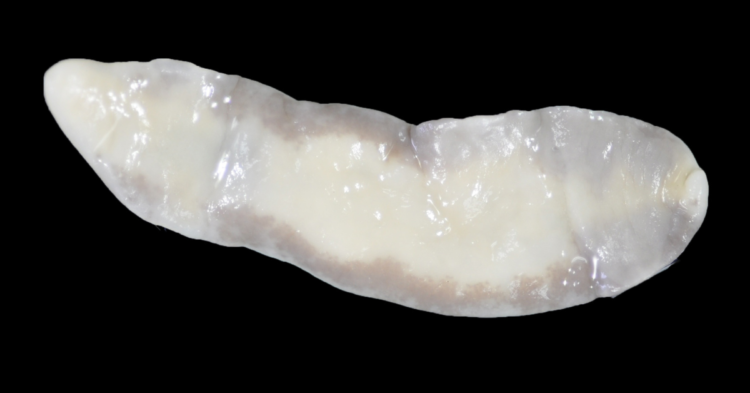Flukes (Fasciola) are flatworms that live in the intestines, liver, lungs and blood.
Common Sources of Infection—Water and contaminated pasture.
Fasciola magna picture reference: https://instruction.cvhs.okstate.edu/jcfox/htdocs/clinpara/lst21_30.htm
Here is a picture of a Fasciola hepatica egg from a fecal sample (the eggs do not float well, so sometimes a special device called a Fluke Finder is used) stained with iodine.
Fasciola magna egg picture reference: https://harvest.cals.ncsu.edu/surveybuilder/form.cfm?TestID=9000
In vet school we learned that standing water areas should be fenced off as they contain lots and lots of snails (and the specific snail that is part of the fluke lifecycle). These types of snails particularly like to breed in water cress and water chestnuts–foods that wild game often eat. The livers of wild game are often filled with flukes. These flukes can be seen when the liver is cut open and often the liver is malformed.
Fluke Life cycle reference: https://blass.com.au/definitions/fasciola
Flukes, Intestinal
More than 50 different species of intestinal trematodes (flukes) exist. Only a few species cause infection in humans, and the most common human intestinal trematode is Fasciolopsis buski. In the genus Echinostoma, Echinostoma ilocanum is the most common organism causing infection in humans. Heterophyes heterophyes and Metagonimus yokogawai are less frequent causes of human intestinal fluke infection. Other intestinal flukes that rarely cause human intestinal infection are Gastrodiscoides hominis, Phaneropsolus bonnei, and Prosthodendrium molenkampi.
Symptoms of Fluke Infestation: Abdominal pain, diarrhea, icterus (jaundice), toxemia and sometimes laryngopharyngitis (throat swelling causing the inability to talk, also called Halzoan). Intestinal flukes cause inflammation, ulceration, and mucous secretion at the site of attachment.
Severe infections including toxic diarrhea alternating with constipation and hunger pangs, liver damage, weight loss, ascites (fluid buildup in the abdomen) intestinal obstruction or malabsorption leading to hypoalbuminemia, protein-losing enteropathy, and impaired vitamin B-12 absorption. As the infection progresses and the worm burden increases, edema of the face, abdominal wall, and lower limbs is observed, as well as ascites and generalized abdominal pain. Anorexia, nausea, and vomiting are also common. The diarrhea persists, becoming greenish-yellow and exceptionally stinky. In patients infected with H. heterophyes, embolization of the eggs can lead to myocarditis, chronic heart failure, or cerebral emboli.
Life Cycle of the Fluke: The immature eggs are discharged from human feces and reach fresh water, hatching after 3-7 weeks and forming miracidia. Upon contact with host snails, the miracidia penetrate the soft tissues and form sporocysts, first- and second-generation rediae, and, lastly, cercariae. The cercariae encyst on various plants such as water caltrop, water chestnut, lotus (on the roots), water bamboo, and other aquatic vegetables. Humans are infected by consuming these raw vegetables. In the human duodenum, the metacercariae attach to the walls and become adult worms in approximately 3 months. The adult worm (see causes traumatic, toxic, and obstructive damage to the intestinal mucosa. At the site of attachment, deep inflammatory ulcerations are observed. Large numbers of worms provoke excess mucous discharge and can obstruct the lumen. The adult worm metabolites can also cause intoxication and sensitization when absorbed via the lumen.
Diagnosis and Treatment for Flukes: Microscopic exam of feces or bile to see the fluke eggs. The first blood ELIZA test may be falsely positive if the person has recently ingested liver from an infected animal. Praziquantel, Albendazole, Biothiol, antispasmodics, iron supplements, and vitamins.
Prevention of flukes: Human and pig feces should not be used as fertilizers, eliminate or fence off snail habitat so herbivores cannot ingest the snails; lightly cook predisposed vegetables and fish; never eat raw liver!
- Pictures of Fasciola: https://www.dpd.cdc.gov/dpdx/HTML/ImageLibrary/Fascioliasis_il.htm

